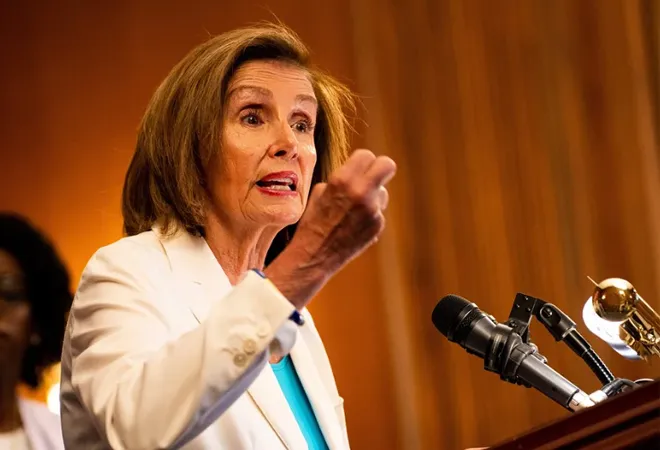
India’s muted response to the United States (US) House Speaker Nancy Pelosi’s recently concluded Taiwan visit has been an issue of intense discussion within the Chinese strategic community. Chinese observers note that after Speaker Pelosi's controversial Taiwan trip,
many countries have chosen sides. For example, countries like Russia, Belarus, and North Korea have strongly supported China, while others like South Korea and ASEAN nations have reiterated their strong adherence to the ‘One China Principle’. Meanwhile, the US and its allies and partners, particularly the G7, EU, and the QUAD members have been critical of Chinese actions and warned it not to try to change the status quo in the Taiwan Strait. However, amongst these, India has taken a unique stance, that of complete silence in the initial days, later followed by a statement calling for restraint, while also not explicitly endorsing the ‘
One China Policy’.
< style="color: #000000">Chinese critique of India’s response to the Pelosi episode
In the Chinese assessment, the
reason why India avoided a provocative response on the issue is mainly because India cannot afford to get dragged into the great power competition and further
antagonise China, particularly at a time when border negotiations are going on in full swing. Initially, certain Chinese observers appreciated India’s silence and interpreted it as
silent support for China's position on the Taiwan Strait issue and as a rebuff to the US. Some even argued that China needs to distinguish between its primary (Taiwan Strait) and secondary (China–India border dispute) contradiction and that there is no need for China at present to further
intensify the contradiction with India.
Chinese strategists claim that India has “deliberately” chosen the time and place (less than 100 kilometres away from the LAC) of the exercise to convey a stern message to China.
However, before long, the Chinese discourse once again became critical of India, on grounds that although India has kept its official response to the Pelosi visit low-key, it has been making its overall antagonistic stance toward China clear through its
tough actions on other fronts, including its
vocal opposition to the docking of the Yuan Wang 5 in Sri Lanka, its actions against
Chinese companies in India among others. What has
perturbed the Chinese side most was the news of India and the US planning to hold the 18
th edition of the annual “Yudh Abhyas” exercise in the Auli region in Uttarakhand from October 14 to 31. Chinese strategists claim that India has “deliberately” chosen the time and place (less than 100 kilometres away from the LAC) of the exercise to convey a stern message to China. “Taking into account the recent military tensions in the east of China caused by Pelosi's visit to Taiwan, India's choice of this opportunity to conduct the India–US joint military exercise also seems to remind China that it may face the dilemma of ‘two-front warfare,’ notes
Lin Minwang, Researcher, Institute of International Studies, Fudan University.
< style="color: #000000">China’s growing concern over a two-front crisis
It is important to note that post the Galwan Valley clash in 2020, there has been discussion in the Chinese media about China’s multi-front challenge and military threats emanating from various directions at the same time. The recent development in the Taiwan Strait has once again spurred debates and discussions on similar lines, “with
collusion between the US and Taiwan in the east, and worsening China-India ties in the West, can China win two wars at the same time? How should it
plan ahead and take precaution”.
China remains highly concerned about India-US military cooperation, particularly those aimed at improving India’s combat capability at the LAC.
Even though the issue gets little attention from the Indian strategic community, in the Chinese strategic thinking, its primary and secondary strategic directions i.e the Taiwan strait and China–India disputed border, are very much inter-connected and correspond to each other. Many Chinese
observers believe that the real reason why the US, which has lost a lot of military advantages vis-á-vis China in the 21
st century, attaches great importance to its relations with India is that, among all its allies, India is the only one who can open up a “second battlefield” for China. It comes as no surprise that China remains highly concerned about India-US military cooperation, particularly those aimed at improving India’s combat capability at the LAC.
Between its two strategic directions, China
prefers and prioritises the Taiwan front not only because of
Chinese nationalism or the Chinese Communist Party’s quest for national rejuvenation but also because Taiwan has huge strategic value for China. Taking over Taiwan would
mean China achieving a major breakthrough against the first island chain, rendering the US’s biggest trump card against China useless, preventing other nations from taking advantage of the cross-strait tension, and thereby freeing its diplomatic resources as well as its defence forces for greater mobility in other strategic directions. In other words, control over Taiwan will mean China getting economically and militarily strengthened to pursue its other global ambitions.
If China manages to complete its operation against Taiwan swiftly, through a surprise military campaign, without giving its opponents a chance to counterattack, it can still avoid major trouble on this front.
Moreover, for the Chinese side, Taiwan is often seen as low-hanging fruit, on
grounds that the PLA's comprehensive strength not only has an overwhelming advantage over Taiwan but also has a certain advantage over the US military in the Western Pacific region. Further, it is argued that, unlike the China-India front, the Taiwan front has a clear end in sight, i.e the expedition ends with China completely taking over the island and making it yet another Hong Kong. Indeed, there is a risk that the Taiwan Strait crisis may lead to a direct China-US conflict or may detonate
three-battle fields—the Taiwan Strait in the East, the China–India border in the West and the South China Sea in the South. It is hoped that if China manages to complete its operation against Taiwan swiftly, through a surprise military campaign, without giving its opponents a chance to counterattack, it can still avoid major trouble on this front. The idea is to compel the US, Japan, and others to accept the changes in the Taiwan Strait as a fait accompli. Moreover, what also goes in China’s favour, in this case, is that any Chinese action against Taiwan will be seen by a substantial section of the international community as “China’s national reunification” rather than foreign aggression.
However, the China-India front, it is argued, is very different. China, it is noted, cannot recover its claimed territories against India through minor border wars but will need to undertake a full-scale war against India. Many in China consider the western front to be China's major weakness or its
soft under-belly. Unlike the southeast coast, where China has operated a military deployment system for decades and enjoys superiority in almost all aspects of sea and air defence, the northwest is understood to be a “
weak area” for China's military deployment. China’s garrisons here are smaller compared to that of India, air defence is relatively weak, still heavily dependent on a large air force base in Chengdu, which is far away from the border region. Some even
fear that in case of a two-front war, since the vast majority of the PLA airforce will be tasked to ensure the safety of the southeast coast, the western front may be forced to fight without adequate air supremacy and support.
The Chinese and Indian people will “fight to death” but the disputes between the two will never end, thereby engulfing China into a quagmire of conflict in various directions.
Moreover, as per the
Chinese assessment, China has little to gain from prioritizing the western front over Taiwan. The key concern is that if China gets sucked into a premature conflict with India, the situation in the Taiwan Strait, which is presently much in China’s favour, might change forever, making the prospect of Cross-Strait unification even more challenging than it is now. On the other hand, India being a big country with the world’s largest population, it is unlikely that China can solve the India problem with just one military operation. Even if China manages to recover its claimed territory through a large-scale war, India as a nation will never reconcile to this defeat. The Chinese and Indian people will “
fight to death” but the disputes between the two will never end, thereby engulfing China into a
quagmire of conflict in various directions. The Chinese strategy, therefore, is to avoid large-scale conflicts on its western front as long as the Taiwan issue remains unresolved. At the max, it can carry out a head-on attack against India and quickly let go of the fight, to teach India a lesson without getting into a prolonged conflict. Once Taiwan is taken over, it is argued, the PLA will have a freer hand to deal with India, and even recover territories, including what China calls its “South Tibet”, thereby coercing India into submission, with or without a conflict.
< style="color: #000000">Conclusion
Although in India, relations with Taiwan are largely seen from the prism of mere strategic posturing vis-á-vis China, however, as evident from the above discussion, Taiwan plays a critical role in India’s security as well. For if Taiwan gets absorbed, China, in all likelihood, will turn against India next, this time with its full might. Therefore, it will be a short-sighted policy for India to
look the other way when a crisis unfolds in the Taiwan Strait, or
dismiss it as a distant “Great Power competition”. On the other hand, it is equally untenable a
proposition that India must shoulder greater responsibility and put boots on the ground or send warships to safeguard Taiwan, located thousands of kilometres away from India. Instead, what India can and must do is cooperate with like-minded nations to further bolster its position and capability at the LAC, building up greater pressure on the Chinese side and further intensifying its two-front dilemma. That way India can ensure its own security as well as play a positive role in securing a free and open Indo-Pacific region. From that perspective, the upcoming “Yudh Abhyas” looks like a good start in the right direction.
The views expressed above belong to the author(s). ORF research and analyses now available on Telegram! Click here to access our curated content — blogs, longforms and interviews.



 India’s muted response to the United States (US) House Speaker Nancy Pelosi’s recently concluded Taiwan visit has been an issue of intense discussion within the Chinese strategic community. Chinese observers note that after Speaker Pelosi's controversial Taiwan trip,
India’s muted response to the United States (US) House Speaker Nancy Pelosi’s recently concluded Taiwan visit has been an issue of intense discussion within the Chinese strategic community. Chinese observers note that after Speaker Pelosi's controversial Taiwan trip,  PREV
PREV


